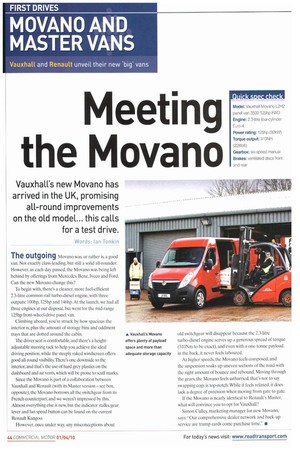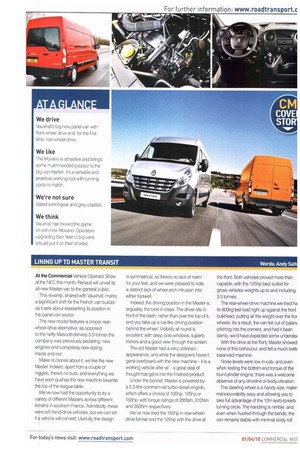Meeting the Movano
Page 44

Page 45

If you've noticed an error in this article please click here to report it so we can fix it.
Vauxhall's new Movano has arrived in the UK, promising all—round improvements on the old model... this calls for a test drive. Words: Ian Tonkin The outgoing Movano was, or rather is, a good van. Not exactly class-leading. but still a solid all-rounder. However, as each day passed, the Movano was being left behind by offerings from Mercedes-Benz, Ivcco and Ford. Can the new Movano change this? To begin with, there's a cleaner, more fuel-efficient 2.3-litre common-rail turbo-diesel engine, with three outputs: 100hp, 125hp and 146hp. At the launch, we had all three engines at our disposal, but went for the mid-range 125hp front-wheel-drive panel van. Climbing aboard, you're struck by how spacious the interior is. plus the amount of storage bins and oddment trays that are dotted around the cabin. The driver seat is comfortable, and there's a heightadjustable steering rack to help you achieve the ideal driving position, while the steeply raked windscreen offers good all-round visibility. There's one downside to the interior, and that's the use of hard grey plastics on the dashboard and air vents, which will be prone to scuff marks Since the Movano is part of a collaboration between Vauxhall and Renault (with its Master version see box, opposite), the Movano borrows all the switchgear from its French counterpart, and we weren't impressed by this Almost everything else is new, but the indicator stalks, gear lever and fan speed button can be found on the current Renault Kangoo.
However, once under way, any misconceptions about old switchgear will disappear because the 2.3-litre turbo-diesel engine serves up a generous spread of torque (310Nm to he exact), and even with a one-tonne payload in the hack, it never feels laboured.
At higher speeds, the Movano feels composed, and the suspension soaks up uneven sections of the road with the right amount of bounce and rebound. Moving through the gears, the Movano feels unhurried, that's not to say swapping cogs is top-notch. While it feels relaxed, it does lack a degree of precision when moving from gate to gate.
If the Movano is nearly identical to Renault's Master, what will convince you to opt for Vauxhall?
Simon Culley, marketing manager for new Movano, says:"Our comprehensive dealer network and back-up service are trump cards come purchase time.
At the Commercial Vehicle Operator Show at the NEC this month, Renault will unveil its all-new Master van to the general public.
This revamp, shared with Vauxhall, marks a significant shift for the French van builder as it sets about reasserting its position in the panel van sector.
The new model features a proper rearwheel-drive alternative, as opposed to the hefty Mascott-derived 3.5-tonner the company was previously pedalling, new engines and completely new styling inside and out.
Make no bones about it. we like the new Master. Indeed, apart from a couple of niggles, there's no buts, and everything we have seen pushes the new machine towards the top of the league table.
We've now had the opportunity to try a variety of different Masters across different terrains in southern France. Admittedly, these were left-hand-drive vehicles, but we can tell if a vehicle will convert. Usefully, the design is symmetrical, so there's no lack of room for your feet, and we were pleased to note a distinct lack of wheel-arch intrusion into either footwell.
Indeed, the driving position in the Master is, arguably, the best in class. The driver sits in front of the dash, rather than over the top of it, and you take up a car-like driving position behind the wheel. Visibility all round is excellent, with deep side windows, superb mirrors and a good view through the screen.
The old Master had a very utilitarian appearance, and while the designers haven't gone overboard with the new machine it is a working vehicle after all -a great deal of thought has gone into the finished product.
Under the bonnet, Master is powered by a 2.3-litre common-rail turbo-diesel engine, which offers a choice of 100hp. 125hp or 150hp. with torque ratings of 285Nm, 310Nm and 350Nm respectively.
We've now tried the 150hp in rear-wheeldrive format and the 125hp with the drive at the front. Both vehicles proved more than capable, with the 125hp best suited for gross vehicles weights up to and including 3.5 tonnes.
The rear-wheel-drive machine we tried ha its 800kg test load right up against the front bulkhead, putting all the weight over the fror wheels. As a result, the van felt out of balanc pitching into the corners, and had it been damp, we'd have expected some understei With the drive at the front, Master showed none of this behaviour, and felt a much belt( balanced machine.
Noise levels were low in-cab, and even when testing the bottom end torque of the four-cylinder engine, there was a welcome absence of any driveline or body vibration.
The steering wheel is a handy size. makin manoeuvrability easy and allowing you to take full advantage of the 12m kerb-to-kerb turning circle. The handling is nimble, and even when hustled through the bends, the van remains stable with minimal body roll.






























































































































































































